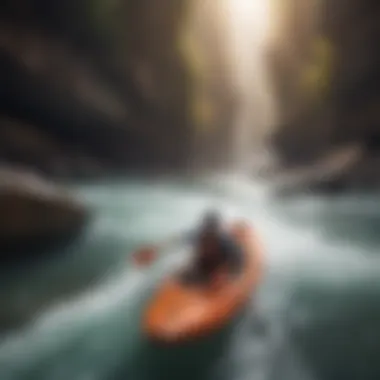Beyond the Canyon: Limits of Extreme Sports


Intro
Extreme sports are not just a fleeting trend; they represent a movement that ignites the spirit of adventure in countless individuals. These activities push individuals beyond what they thought were their limits, opening up new avenues for personal growth and exploring the edges of their physical capabilities. From adrenaline-pumping base jumping to the serene yet daunting path of rock climbing, participants engage not just in physical challenges but also in mental battles that test their resolve.
The concept of "canyon exceed" serves as a metaphor for this thrilling journey. Traversing the crevices of fear and doubt, athletes find their own unique path through uncharted territories. In this article, we will look at how adventurers push their boundaries, highlighting techniques, safety measures, gear, and the cultural significance behind extreme sports. More than just a pursuit of thrill, these activities forge a community of adventurous souls connected by their desire to explore the impossible, much like those who traverse the majestic canyons of the world.
Through the lens of extreme sports, we uncover the deeper meanings and connections that emerge when engaging with nature and confronting our personal limits. The adventure doesn't just lie in the act itself; it resides in the journey, the growth, and the camaraderie shared among those who dare to leap into the unknown.
Understanding the Concept of 'Canyon Exceed'
The term "Canyon Exceed" emerges as a pivotal notion in the realm of extreme sports, representing not just a physical boundary but also a psychological challenge that athletes and adventurers face. At its core, this concept embodies the relentless pursuit to extend one's limits, pushing beyond the safe and comfortable to embrace the thrill of the unknown. In this article, the discussion surrounding Canyon Exceed will focus on its relevance to extreme sports, illustrating how these athletes integrate this idea into their pursuits for greater achievements and personal growth.
Defining 'Canyon Exceed' in Extreme Sports
Defining "Canyon Exceed" necessitates looking deeper than the mere act of surpassing a cliff or a canyon edge. It paints a vivid picture of how extreme sport enthusiasts engage in activities that challenge both their physical abilities and mental fortitude. This term encapsulates a variety of scenarios where athletes find themselves confronting natural obstacles, be it rock climbing, base jumping, or white-water rafting. These endeavors fundamentally require not only technical skills but also an unyielding spirit that refuses to be confined by fear or self-doubt.
The concept can be described as crossing thresholds—both figurative and literal. When climbers tackle notoriously difficult routes, they handle more than just grips and footholds; they navigate fear, anticipation, and the thrill of potential failure. By defining the boundaries that each individual sets for themselves, Canyon Exceed becomes a deeply personal journey, built on the experiences of pushing through to the other side.
Metaphoric Significance in Adventurous Pursuits
Metaphorically speaking, "Canyon Exceed" stands as a testament to the broader essence of adventure. It represents the internal canyons each individual must traverse in their quest for self-discovery and achievement. Every jump into a river, every climb up a steep wall signifies what many aspire to conquer in life—a journey of transformation that reshapes one's limitations into capabilities.
"To truly embrace our potential, we often must leap into the abyss, emerging wiser and stronger."
In this sense, the canyon is not merely a physical location but a rich symbol of challenges lurking in everyday life. Adventurers learn to confront the unknown, honing skills that extend beyond extreme sports and into areas like career and personal relationships. They bring back experiences and lessons that ripple through their communities, inspiring others to confront their canyons—whether they are emotional, physical, or social.
Furthermore, by pushing their limits, extreme sports enthusiasts foster a culture that embraces risk and promotes resilience. They inspire a community narrative where fears are faced and limits redefined. This interplay between the physical act of exceeding boundaries and the metaphorical journey allows for personal growth that goes far beyond the sport itself.
In summary, the concept of "Canyon Exceed" serves as an essential framework within extreme sports, encouraging individuals to continuously push beyond their constraints, ultimately crafting a narrative filled with bravery, perseverance, and transformation.
Extreme Sports: A Brief Overview
Extreme sports captivate adventurers as they blend adrenaline and skill. These activities push personal boundaries, leading to remarkable physical and mental growth. Understanding the landscape of extreme sports offers insights into why many pursue them and how they impact lives.
Extreme sports often serve as a canvas for individuals to express themselves. Participants are not just seeking thrills; they are exploring the limits of human capability. By engaging in these pursuits, athletes can find a sense of freedom and accomplishment. The thrill of exceeding one’s own expectations can translate into other life areas, fostering resilience, courage, and determination.
In this article, we will explore various facets of extreme sports, breaking down the categories, their cultural ramifications, and the communities they nurture. The goal is to paint a comprehensive picture that illustrates the interplay of risk and reward that these activities represent.
Categories of Extreme Sports
Water Sports
Water sports embrace a multitude of activities like surfing, kayaking, and wakeboarding. These activities are not just about mastering the waves; they also emphasize connection to nature. The key characteristic of water sports is the reliance on water conditions, making each experience uniquely unpredictable.
Water sports offer both exhilaration and a chance for meditation, as riders find themselves fully present in the moment. However, they come with risks – understanding currents and weather patterns can be crucial for safety. The rush of riding a wave or navigating a swift river contributes significantly to the appeal. Few things can match the adrenaline surge from mastering a surfboard or racing down a river.
Snow Sports
Snow sports encompass skiing, snowboarding, and snowmobiling, among others. The marvel of gliding down pristine slopes is what draws many to these activities. Skiing and snowboarding showcase not only athletic abilities but also an appreciation for winter landscapes, offering scenic views that can be breathtaking.
The challenge of snow sports lies in their learning curves. Mastering balance on slopes or maintaining speed while navigating turns means that athletes often invest significant time honing skills. This aspect fosters a sense of achievement as they push their limits while appreciating nature’s beauty. Although the cold and weather conditions can pose challenges, the thrill of descending an icy mountain makes the effort worthwhile.
Air Sports
Air sports like skydiving, paragliding, and wingsuit flying take adventure to another level. The key characteristic here is freedom; the sensation of soaring through the air provides an unparalleled experience. Each flight offers an opportunity to confront fear, engaging with nature from the skies.
Skydiving, for example, combines a profound mental challenge with stunning views, as jumpers find themselves on the threshold between earth and sky. However, mastering the necessary techniques and ensuring safety require discipline and preparation, demanding commitment from participants while offering profound rewards.
Land Sports
Land sports cover a vast range of activities, including rock climbing, mountain biking, and parkour. Utilizing natural terrains, these sports emphasize strength and agility as athletes confront various challenges. The diversity in land sports means there’s something for everyone, appealing to both thrill-seekers and those looking for understated adventures.
One standout feature is the community that often forms around land sports. Participants share routes, tips, and stories, creating bonds that deepen their experience. However, the risks associated with land sports, such as falls or injuries, can deter some. Yet, for many, the reward of conquering a difficult trail or reaching the peak of a climb outweighs the potential downsides.
Popularity and Cultural Impact
Global Reach
The popularity of extreme sports has surged internationally. As a result, many of these activities have become part of popular culture, represented through media and films. The global reach translates to diverse participation; enthusiasts from various backgrounds engage in extreme sports, making them a shared experience across borders.
This international flavor broadens the appeal. It contributes to tourism, as locations renowned for extreme sports draw visitors eager to test their limits. Nevertheless, the commercialization of these activities can sometimes overshadow their intrinsic value, presenting both opportunities and challenges for traditional practices.
Influence on Lifestyle
Extreme sports often mold lifestyles. Many participants adopt fitness routines and prioritize health to excel in their chosen activities. Others find that these sports transcend leisure, becoming essential components of their identity. This lifestyle can cultivate a sense of community among thrill-seekers, where shared experiences lead to lasting friendships.
However, such pursuits do demand time and investment, potentially leading to conflicts with other life priorities. The focus on adventure can bring about a sense of purpose, yet maintaining balance is crucial to avoid burnout.
Community Aspects
The community built around extreme sports significantly enriches the experience. Many athletes find camaraderie through training, events, or local meet-ups. Online platforms and social media further help forge connections among enthusiasts worldwide.
While the community fosters support and motivation, it can also lead to competition, sometimes creating pressure on participants to constantly outdo themselves. The blend of support and challenge cultivates a dynamic environment where individuals push personal limits and celebrate collective achievements.
">The camaraderie formed in extreme sports often leads to lifelong friendships rooted in shared challenges and experiences.


Understanding these threads weaving through extreme sports helps illustrate why they resonate with so many. From the physical challenges they pose to the communities they build, extreme sports truly reflect the human spirit's desire to push boundaries.
Challenges Faced by Extreme Sports Athletes
When it comes to extreme sports, the obstacles athletes face are substantial, often pushing them to their absolute limits. The significance of these challenges is not just physical but deeply mental as well. Understanding these challenges helps to highlight the immense willpower and dedication required to engage in these high-stakes activities, offering insights into the very essence of what it means to be an extreme sports athlete.
Physical Demands of Extreme Activities
Strength and Agility
Strength and agility are two vital components in the arsenal of any extreme sports athlete. These attributes significantly enhance performance across numerous disciplines, from rock climbing to motocross. Athletes need strength not just to perform but to recover and manage injuries that arise from the extreme demands of activity. Agility, on the other hand, enables quick reactions, which can be the difference between a successful run and a painful fall.
A key characteristic of strength is its role in muscle development; powerful muscles are essential for enduring the grueling demands of these sports. This makes it a celebrated choice for anyone looking to up their game. Agility comes into play through various trainings, such as plyometrics or balance exercises, allowing athletes to improve their dexterity seamlessly.
However, one unique feature of focusing too much on strength is that it might lead to neglecting flexibility, which can be just as crucial. While strength builds power, lacking agility can slow a response to unexpected movements, leading to frustrating setbacks or injuries.
Endurance Training
Endurance training is another cornerstone in the world of extreme sports. Having the stamina to sustain long sessions of high activity can define success, especially in endurance-heavy sports like ultra-marathons, trail running, or mountain biking.
The key characteristic here is sustained energy output over extended periods without significant fatigue. This makes endurance training a popular choice among extreme athletes who are always looking to push themselves further.
Distinctive features include diverse training modalities like interval training, long runs, and high-intensity workouts, giving an athlete the tools to push through mental barriers as much as physical. Yet, one downside to focus solely on endurance can be muscle loss over time if strength training is neglected.
Mental Resilience and Focus
Overcoming Fear
The aspect of overcoming fear cannot be underestimated; it forms the bedrock of mental resilience in extreme sports. This challenge is not merely about confronting the physiological response of fear but is an ongoing mental battle which deals with self-doubt and paranoia about safety. Fear can often be a great hindrance, but conquering it allows an athlete to explore their limits more fully.
A key characteristic of overcoming fear is its transformative power. Learning to manage fear leads to a higher level of self-confidence, making it an invaluable skill. This article places great emphasis on this point, demonstrating the benefits of athletes who have learned to navigate their fears which subsequently enables them to perform at peak levels.
However, the unique feature of facing fear is that it can be a double-edged sword; one must tread carefully, lest they become reckless in their quest to conquer fear, leading to accidents.
Building Mental Toughness
Building mental toughness is a crucial endeavor that complements physical strength and endurance in extreme sports. This aspect involves nurturing a mindset that promotes resilience, determination, and an unwavering focus on goals. Mental toughness serves to bolster an athlete’s ability to push through pain, fatigue, or adversity while enhancing performance over time.
The primary characteristic of mental toughness is perseverance; athletes who cultivate it can remain committed even in the face of challenges. This contributes significantly to achieving personal excellence, making it an indispensable choice in extreme sports. There’s a unique feature to developing mental toughness that separates it from potential mind games; it requires practice, and often great failure, to truly understand what one's limits are.
Yet, it's also worth noting that too much emphasis on mental toughness might lead to overlooking emotional health. Oftentimes, athletes feel pressured to appear resilient, disregarding their need for recovery and vulnerability, both of which are equally essential for long-term success.
"In extreme sports, where limits are constantly pushed, the greatest success is born from conquering both physical hurdles and mental barriers."
In summary, the challenges faced by extreme sports athletes are a multifaceted aspect of their journey. By exploring the physical demands of strength, agility, and endurance training, along with the pivotal mental components of overcoming fear and building mental toughness, one gains a comprehensive understanding of the complexity behind extreme sports. It is through acknowledging these challenges that athletes can prepare themselves for the extraordinary adventures that await.
The Role of Technology in Extreme Sports
Technology has become a real backbone in the world of extreme sports. Whether you’re scaling steep cliffs or hurtling down snowy slopes, advancements in tech improve safety, enhance performance, and create more immersive experiences. In the adrenaline-fueled arena of extreme sports, harnessing the right tools is essential not just for thrill-seeking but also for pushing boundaries like never before. By integrating smart devices and innovative equipment into their routines, athletes can ensure they're always one step ahead, make informed decisions, and take well-calculated risks.
Innovations in Gear and Equipment
Wearable Technology
Wearable technology has transformed the landscape of extreme sports by providing athletes with real-time data. Devices like smartwatches, fitness trackers, and heart rate monitors allow extreme athletes to keep tabs on their physical conditions while performin activity. One key characteristic is the ability to monitor vital signs such as heart rate, calories burned, and even oxygen levels, all while engaged in high-octane challenges.
The unique feature of these devices is their real-time feedback, which can significantly improve performance. For instance, a rock climber can check their heart rate to prevent exhaustion before reaching the summit, thus pushing their limits more prudently.
However, these devices do come with their disadvantages as well. Battery life can be a concern during long expeditions, and sometimes too much focus on metrics can distract from the experience itself. When paired with careful planning, though, wearable tech offers a distinct advantage—greater safety and performance metrics in pursuits that often flirt with danger.
Safety Equipment
In the realm of extreme sports, safety equipment is not just a precaution; it's a necessity. Innovations like impact-resistant helmets, reinforced climbing harnesses, and advanced flotation devices can be the difference between serious injury and a mere scrape. These are designed with cutting-edge materials that ensure stability and protection in unpredictable environments.
One key characteristic of safety equipment is its customization options, which allow athletes to tailor gear to their specific activities. The flexibility to adjust fit and functionality means better comfort, which is critical when undertaking something as thrilling yet dangerous as skydiving or mountain biking.
The unique feature here is the improved functionality without compromising on safety standards. While these enhanced safety measures bring peace of mind, they can also lead to a false sense of security if not used correctly. Knowing the limits of both the gear and one’s own abilities is crucial for any adventure.
The Influence of Social Media
Social media is not just where extreme sports aficionados share their thrill-seeking stories; it’s a powerful tool that shapes the culture surrounding these activities.
Promoting Sports
Promoting sports through social media has changed how people engage with extreme sports. Platforms like Instagram and TikTok allow athletes to showcase their skills and document their experiences, reaching audiences they may not have otherwise connected with. A key characteristic of this promotion is its visual storytelling element. Stunning photography and videos capture the essence of extreme sports, driving interest and participation.
These platforms provide an easily accessible avenue for aspiring adventurers to learn from seasoned athletes. Moreover, promoting diversity by showcasing underrepresented athletes can inspire a wider audience to explore various sports. Nevertheless, the inherent pressure to perform and share can sometimes lead to athletes taking risks for views, which is something that needs careful consideration.
Building Communities
Building communities through social media creates a sense of belonging among extreme sports enthusiasts. Online platforms foster spaces where individuals can share tips, join discussions, and even plan meet-ups for various sports. One key characteristic of such communities is their supportive nature—athletes can seek advice and motivation from peers who share the same passions. It’s gratifying and inspiring to see fellow thrill-seekers encouraging each other.
A unique feature of these communities is their ability to transcend geographical barriers. Enthusiasts from different parts of the world, whether in New Zealand or Colorado, can exchange knowledge and experiences firsthand. However, there’s a downside; reliance on social media validation can detract from the intrinsic love of the sport.
"In the quest for adventure, our devices serve as both tools and companions, guiding us while urging us to stay within the challenges we've set."


Through these various facets of technology, extreme sports continue to evolve. By blending innovation with tradition, we witness a transformation that keeps pushing the limits not just physically, but also in how we share and engage with the world around us.
Safety Measures in Extreme Sports
Safety measures in extreme sports are not merely guidelines; they form the backbone of every successful adventure. While the thrill of these activities is undeniable, it is the approach to safety that distinguishes experienced athletes from novices. Recognizing risks, embracing appropriate gear, and understanding the environment all play crucial roles in ensuring not just survival but a rewarding experience.
Assessing Risks
Understanding Terrain
Understanding terrain is fundamental for anyone engaged in extreme sports. Every landscape has its own quirks, and navigating these complexities can mean the difference between a flawless adventure and a perilous situation. For instance, slick rock formations can seem harmless but can unexpectedly alter the dynamics of climbing, often leading to slips or falls if not approached with the right caution. The topography can signal the kind of physical preparation one might need, whether it’s adjusting climbing techniques to manage steep descents or preparing one's body for a lengthy hike across rocky expanses. This awareness makes terrain analysis a fundamental aspect that cannot be overlooked.
The value of insights derived from fellow adventurers and guides cannot be overstated. Individuals who have walked the trails or climbed the cliffs often furnish valuable information about hidden dangers or advantageous shortcuts that are not always apparent on first glance. This informal knowledge often leads to enhanced safety.
Weather Conditions
Weather conditions represent another layer to assess before embarking on any extreme sport. They can shift with barely a moment's notice, transforming what was once a manageable environment into a threatening one. For example, while a sunny day at the canyon might suggest a warm welcome, the sudden arrival of rain could create dangerous conditions for rock climbers or increase the risk of flash floods for canyon enthusiasts.
Monitoring weather forecasts is vital. Equipped with knowledge about impending storms or atmospheric changes, athletes can proactively alter their plans to ensure a safe experience. Possessing familiarity with how different weather phenomena impact specific locations enhances not only safety but also the overall experience.
Essential Safety Gear
No discussion of safety measures is complete without mentioning essential safety gear. The right equipment serves as an invisible shield against potential risks. For instance, a high-quality helmet isn’t just a piece of regulation—it’s a lifesaver in rock climbing. Similarly, specialized footwear can prevent not just discomfort but also critical missteps.
When it comes to the community aspect, a shared enthusiasm for top-notch gear fosters a culture of safety among enthusiasts. Discussing the latest innovations in safety equipment can not only create connections but also provide insights into making safer choices on the field. Those moments of camaraderie and knowledge-sharing in local meet-ups or online forums make all the difference, enhancing the fabric of the extreme sports community.
"Extreme sports are not just about pushing limits; they're about knowing how to stay safe while doing it."
In summary, the interplay between risk assessment, awareness of environmental factors, and reliance on safety gear underscores the importance of safety measures in extreme sports. As thrill-seekers navigate their way through mountains, rivers, and skies, it must be emphasized that adrenaline should never overshadow preparedness. An informed and conscientious approach not only ensures one's longevity in the sport but also enhances the communal spirit that thrives within these challenging yet exhilarating pastimes.
Techniques to Exceed Personal Limits
In the vast landscape of extreme sports, the drive to push one’s boundaries is foundational. This section dives into the techniques that help athletes exceed their personal limits, emphasizing physical and mental practices that are essential for success. The essence of extreme sports lies in tackling challenges and coming back stronger, and understanding the right techniques can spell the difference between stagnation and remarkable growth.
Training Routines for Extreme Athletes
Physical Conditioning
Physical conditioning is the cornerstone for anyone serious in extreme sports. Combining strength, flexibility, and endurance, it prepares the body to handle the rigors associated with high-impact activities. Training routines often focus on building core strength, which is critical for explosiveness and balance.
A key characteristic of physical conditioning is its adaptability. Athletes tailor their routines based on their specific sport—whether it’s rock climbing, surfing, or snowboarding. This customization makes physical conditioning a beneficial aspect in extreme sports. Athletes can hone skills pertinent to their discipline, resulting in a more targeted and effective workout regimen.
One unique feature of physical conditioning is the multidisciplinary approach it employs. It can include everything from weightlifting to yoga, thus blending different forms of exercise that enhance overall performance. The advantage here is clear: varied training helps to prevent injury while also improving longevity in one’s sport.
Skill Development
Skill development goes hand-in-hand with physical conditioning. It includes the techniques and tactics specific to an extreme sport that transform a good athlete into a great one. For instance, a surfer must learn to read the waves and position themselves accordingly to ride optimally. This is where the concept of deliberate practice comes into play.
The key characteristic of skill development is that it focuses on the refinement of actions over time. Through repetitive practice, athletes can internalize motions, making their performance feel natural and fluid. It is a popular choice because it encourages athletes to step outside their comfort zones, ultimately boosting confidence and mastery.
One hurdle athletes often face in skill development is the steep learning curve that accompanies new techniques. It may seem daunting at first, but this challenge also brings the possibility for significant growth. Unique to skill development is the feedback loop: video analysis or coaching can provide immediate corrections, allowing for real-time improvement and faster adaptation in techniques.
Mindset Shifts for Performance Enhancement
Mental fortitude is as crucial as physical ability in extreme sports. Mindset shifts allow athletes to enhance their performance by overcoming self-imposed limits. Adapting one’s perspective can turn perceived weaknesses into strengths, and overcoming self-doubt can lead to spectacular achievements.
One effective technique in cultivating the right mindset is visualization. By envisioning success before engaging in a sport, athletes often find an ease in performance. This method works on a psychological level, preparing the mind to handle challenges before they materialize. With the right shifts in thinking, an athlete can turn fear of failure into a motivating force, propelling them to push boundaries.
Ultimately, adopting a growth mindset enables athletes to approach extreme sports with the understanding that every setback is a chance for improvement. Great athletes aren’t just strong or skilled; they have the emotional intelligence to navigate their goals with resilience.
"All progress takes place outside the comfort zone."
This phrase rings especially true in extreme sports, where pushing limits is not just part of the game; it's the entire point. As athletes embrace these techniques, they broaden their horizons and redefine what's possible, much like one would explore the uncharted territories of nature's canyons.
Canyon Experiences in Extreme Sports
Canyons offer a unique playground for thrill-seekers and extreme sports enthusiasts. Their vast expanses and rugged terrains provide a backdrop that not only enhances the adrenaline rush but also challenges athletes to push their boundaries. Engaging with these natural giants allows adventurers to connect with the environment on a deeper level, testing both their skills and their resolve. The essence of pushing limits can truly be captured in the way athletes interact with these landscapes.
Exploring canyons can lead to opportunities for various extreme sports including rock climbing, canyoning, and even paragliding. Each of these activities has its benefits, stretching physical abilities and promoting mental focus. When one stands at the edge of a canyon, looking down at the winding paths below, it’s about more than just the sport; it’s a chance to confront fears and overcome challenges.
Iconic Canyons for Adventure
Grand Canyon
The Grand Canyon is perhaps one of the most recognized natural formations in the world. Its sheer size and spectacular vistas create a sense of awe that attracts adventurers and tourists alike. For extreme sports, its immense cliffs and varied terrain offer an exciting range of activities, from base jumping to rafting in the Colorado River.
A key characteristic of the Grand Canyon is its depth, which reaches over a mile. This feature not only poses a thrilling challenge for climbers but also demands a respectful approach due to the potential dangers involved. The stunning view from the top is a reward like no other, showcasing the majestic colors and shapes that the sun casts throughout the day, creating visual splendor. However, access and safety measures are paramount; the terrain can be unforgiving, and adventurers must come well-prepared.
Antelope Canyon
Antelope Canyon is unique for its narrow passageways and surreal light beams that flood the canyon during certain times of the day. This enchanting venue is a photographer's dream, luring those who appreciate the aesthetics of nature as much as the thrill of adventure. The winding paths and beautiful shades of red rock paint a vivid picture, making it a beneficial choice for those looking to capture the magic of extreme sports in a stunning setting.
One draw of Antelope Canyon is its accessibility; guided tours are available that can cater to various skill levels. However, the narrowness of the paths can pose a limitation for larger groups, and weather conditions can affect accessibility. Safety is a concern during flash floods, which can happen suddenly.
Colca Canyon


Colca Canyon, deeper than the Grand Canyon, is renowned for its breathtaking scenery and rich biodiversity. It serves as a prime location for trekking and offers unique opportunities for spotting majestic Andean condors soaring overhead. The rugged trails promise challenges for those willing to hike its steep ascents.
A notable feature of Colca Canyon is the traditional villages that dot the landscape, providing cultural insights alongside the physical challenge. This mix of nature and culture creates a rich experience for those drawn to extremes. However, the altitude can be a disadvantage for some, requiring acclimatization before embarking on strenuous activities to avoid altitude sickness.
Documented Experiences and Stories
The stories of those who have ventured into these canyons reflect not just the thrill but also personal growth and community bonding. Individual accounts reveal transformative journeys, showcasing moments of fear and elation, often intertwined with life lessons. Each experience highlights the broader impact of pushing limits within these grand landscapes and illustrates how these canyons become a vital space for both personal exploration and collective adventure.
The Community Aspect of Extreme Sports
Extreme sports embody more than just the pursuit of adventure; they promote a vibrant community that fosters connection, collaboration, and camaraderie. The tight-knit atmosphere among enthusiasts creates a sense of belonging, which isn't always found in other hobbies. These communities share not only a passion for adrenaline-driven activities but also values that promote personal growth and ethical conduct in wild environments.
Engaging with others who understand the highs and lows of extreme sports can be both comforting and encouraging, providing a network of support. The mutual respect among participants fosters meaningful relationships. People know their limitations yet are always pushing each other to exceed expectations. This intrinsic motivation often stems from shared experiences, which solidifies bonds that last long after the last wave or climb.
Building Connections through Shared Experiences
When it comes to building connections in the extreme sports arena, shared experiences act like glue that binds individuals together. Whether navigating treacherous whitewater rapids in a kayak or feeling the rush of a downhill mountain bike race, these activities create memories that are difficult to replicate elsewhere.
Sharing the thrill of conquering a new trail or successfully braving a challenging cliff dive leads to conversations that only those who lived through those moments can comprehend. It's in these rigorous activities that friendships form and grow, often outlasting the fear and fatigue of the moment. Many enthusiasts find that they can speak most openly with their peers, discussing everything from the highs of triumph to the lows of failure without judgment.
- Experiences forge ties: Moments like these establish trust and rapport.
- The story-sharing factor: Often, the recounting of experiences becomes a tale that is shared at gatherings and events.
In essence, these profound shared experiences are the backbone of the extreme sports community, enabling individuals not only to connect but also to thrive together.
Events and Gatherings in Extreme Sports
Events and gatherings serve as a crucial platform for enthusiasts to come together, share their passions, and grow collectively. Be it competitions or festive celebrations, these occasions amplify the sense of community that extreme sports embody.
Competitions
Competitions in extreme sports aren't merely contests; they act as milestones where athletes showcase their skills and share their hustle. These events emphasize skill improvement while inspiring others to push their limits. In competitions like the X Games or Red Bull Cliff Diving, participants gain exposure to new techniques and tricks that can elevate their performance.
- Key Characteristic: The unique camaraderie among competitors promotes a spirit of friendly rivalry rather than cutthroat competition.
- Beneficial for Growth: They offer participants invaluable insights into their strengths and weaknesses, which is hugely valuable for personal development.
- Unique Feature: Competitions often have spectators who create an electrifying atmosphere, cheering for participants and fostering a sense of belonging for both athletes and fans.
The downside? Not all competitions can ensure fair conditions, as weather or equipment issues can sometimes hinder performance or safety. Nonetheless, the overall experience can be enriching, creating bonds as participants cheer each other on.
Festivals
Festivals dedicated to extreme sports present another avenue for connection. These events are festive in nature, often combining competitions, exhibitions, and community bonding activities. They draw thrill-seekers from various backgrounds who come together to celebrate their shared passion. Festivals like the Asheville Extreme Sports Festival or the Surfing Festival in Huntington Beach showcase both local and international talent.
- Key Characteristic: The blend of skill display and festive mood creates a welcoming environment for newcomers and veterans alike.
- A Popular Choice: Many view these festivals as a holiday getaway, adding to their charm and allure, combining adventure with leisure.
- Unique Feature: Many festivals offer a range of activities, allowing attendees to try their hands at different sports, thus creating a sense of community and sharing experiences.
There can, however, be challenges. Large crowds can sometimes make personalization difficult, and some might feel overwhelmed. Nonetheless, these gatherings remain significant for building community ties and celebrating the sport.
"In extreme sports, we don’t just push our limits; we extend our community, transforming individual triumphs into shared victories."
Whether through spirited competitions or lively festivals, the communal aspect of extreme sports elevates personal and shared growth, cementing connections that can last a lifetime.
Sustainability and Ethics in Extreme Sports
In the realm of extreme sports, where thrill and adventure reign supreme, the need for sustainability and ethical practices is perhaps more critical than ever. As athletes venture into nature's most stunning landscapes, there's a responsibility that comes with those breathtaking experiences. The adverse effects on the environment, ranging from litter to habitat disruption, are real and pressing issues that demand attention. Therefore, it’s vital to explore this intersection between extreme pursuits and environmental stewardship, thus ensuring that the natural playgrounds we cherish remain intact for generations to come.
Environmental Considerations
Extreme sports inherently call for a communion between humans and the environment. However, improper practices can lead to a myriad of ecological problems. Here are some core aspects to consider:
- Impact on Wildlife: Constant foot traffic or water activities in fragile ecosystems can disrupt local fauna, potentially leading to declines in species that can’t handle the pressure. Protecting these vulnerable populations should be top of mind for adventurers.
- Trail Maintenance: Backcountry skiing, hiking, and mountain biking can easily erode trails and habitats. Proper trail etiquette and maintenance not only help sustain these environments but also enrich the experiences of those who follow.
- Pollution: Trash in remote areas doesn’t just ruin the scenery; it can also harm wildlife and waterways. By carrying everything in and out, athletes display a strong commitment to environmental health.
"We do not inherit the earth from our ancestors; we borrow it from our children."
— Native American Proverb
Promoting Responsible Adventure
Promoting responsible adventure may seem like an oxymoron at first. Yet, as some extreme sports enthusiasts push boundaries in pursuit of the next thrill, the idea is not just to survive the adventure but to protect the setting they love. Here are some proactive approaches to embracing sustainable practices in extreme sports:
- Leave No Trace Principles: These principles help guide outdoor ethics. By following simple guidelines, such as minimizing campfire impacts, respecting wildlife, and disposing of waste properly, athletes can ensure that the wilderness retains its beauty.
- Eco-friendly Gear Choices: From biodegradable soaps to eco-conscious apparel, selecting gear that reduces environmental impact speaks volumes about an athlete’s dedication to sustainability. Brands like Patagonia and The North Face are advocating for responsible manufacturing, which also encourages consumers to choose wisely.
- Educating the Community: Sharing knowledge about local ecosystems and conservation efforts within the sports community can yield significant benefits. Whether through organized events or social media platforms, increasing awareness can lead to collective action toward sustainability.
- Involvement in Clean-Up Initiatives: Many sports communities are getting their hands dirty—not in the dirt of their beloved sports, but in cleaning up the very environments they cherish. Joining or initiating local clean-up projects is a commendable way to give back while enjoying outdoor escapades.
As we dive into the exhilarating world of extreme sports, it's imperative we do so with an understanding of our impact and a commitment to preserving the beauty that surrounds us. The balance, albeit challenging, can yield a richer experience for all involved.
Future Trends in Extreme Sports
As we look ahead, the landscape of extreme sports continues to evolve, driven largely by changes in technology, cultural attitudes, and emerging athlete needs. Understanding these trends offers insight not only into where the sports are heading, but also how participating in them can transform lives, foster communities, and extend the boundaries of human performance. There are several key elements to consider when discussing future trends in extreme sports, including the emergence of new activities and the role of technological innovations.
Emerging Sports and Activities
The world of extreme sports is no longer confined to a handful of established activities. New genres are springing up, pushing the limits of what can be achieved and narrowing down the gaps between various disciplines.
Some of the noteworthy sports emerging among thrill-seekers include:
- Wingsuit Flying: This activity is capturing the imagination of daredevils, allowing them to glide through airspace, pulling off aerobatic stunts.
- E-Sports in Adventure: While not physical in the traditional sense, competitive gaming in extreme sports settings blends technology with extreme competition, drawing significant audiences.
- Base Jumping from Drone: A blend of drone technology and traditional base jumping is on the rise, providing unique perspectives and launch points not available before.
These trends are reshaping the very nature of what constitutes an extreme sport. Participants often bridge these activities into unique personal challenges, developing new communities centered around them. The allure of these emerging sports lies not only in their thrill but also in the sense of belonging they create amongst participants in a fast-paced, constantly changing world.
Technological Advancements Shaping the Future
The intersection of technology and extreme sports is indispensable when examining future trends. Innovations are fundamentally altering how athletes train, compete, and connect. Some important advancements include:
- Wearable Tech: Devices that monitor biometrics in real time are becoming an athlete’s best friend. From heart rate to altitude changes, this data helps athletes optimize performance and enhances safety.
- Virtual Reality Training: VR technology enables athletes to practice in simulated environments. This is particularly beneficial for those participating in high-risk sports where mistakes can have severe consequences.
- Social Media Integration: Platforms like Reddit and Facebook enable extreme sports enthusiasts to share experiences, learn new techniques, and connect with like-minded individuals. The sense of community has never been as strong as it is today.
"The future of extreme sports will be an amalgamation of bold innovation and the enduring quest for adventure. Technology and creativity are the two wings of this evolution."
Such advancements are not just enhancing performance; they are also making extreme sports more accessible. Aspiring athletes can now engage without the prior experience often required in extreme sports, hence broadening the horizon of participation.
Overall, being aware of these future trends in extreme sports allows enthusiasts and newcomers alike to stay ahead in this dynamic field. The importance of these developments cannot be understated—they promise thrilling experiences while paving the way for future generations of adventurers.







